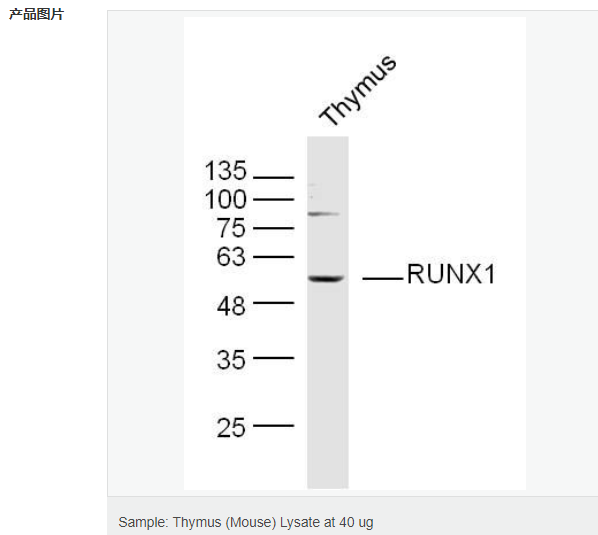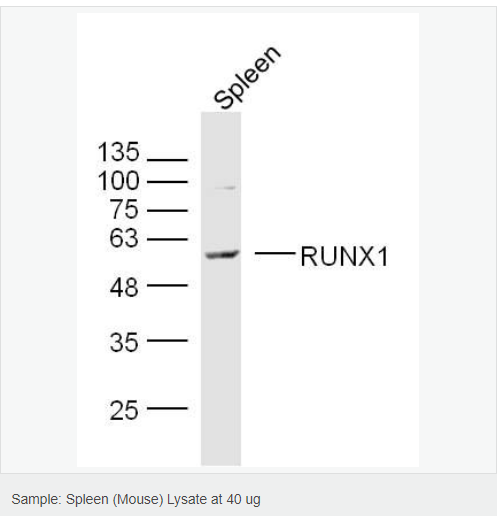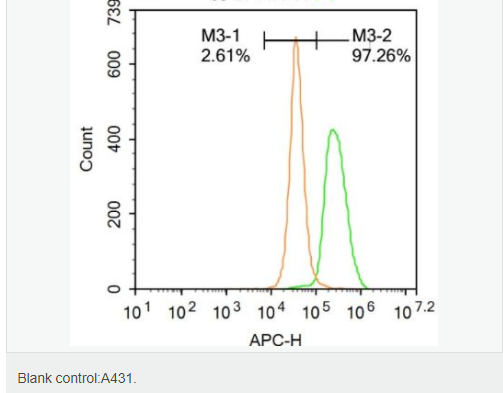
货号
产品规格
售价
备注
BN41846R-50ul
50ul
¥1486.00
交叉反应:Human,Mouse(predicted:Rat,Dog,Cow,Horse,Rabbit) 推荐应用:WB,Flow-Cyt,ELISA
BN41846R-100ul
100ul
¥2360.00
交叉反应:Human,Mouse(predicted:Rat,Dog,Cow,Horse,Rabbit) 推荐应用:WB,Flow-Cyt,ELISA
BN41846R-200ul
200ul
¥3490.00
交叉反应:Human,Mouse(predicted:Rat,Dog,Cow,Horse,Rabbit) 推荐应用:WB,Flow-Cyt,ELISA
| 英文名称 | RUNX1 |
| 中文名称 | 急性髓细胞白血病1蛋白抗体 |
| 别 名 | Acute myeloid leukemia 1; Acute myeloid leukemia 1 protein; alpha subunit core binding factor; AML 1; AML1 EVI 1; Aml1 oncogene; AMLCR 1; AMLCR1; CBFA 2; CBFA2; Core binding factor alpha 2 subunit; Core binding factor runt domain alpha subunit 2; EVI 1; EVI1; HGNC; Oncogene AML 1; PEA2 alpha; PEBP2 alpha B; PEBP2A2; PEBP2aB; Polyomavirus enhancer binding protein 2 alpha B subunit; Run1; Runt related transcription factor 1; RUNX 1; SL3 3 enhancer factor 1 alpha B subunit; SL3/AKV core binding factor alpha B subunit; RUNX1_HUMAN. |
| 研究领域 | 肿瘤 心血管 细胞生物 细胞凋亡 |
| 抗体来源 | Rabbit |
| 克隆类型 | Polyclonal |
| 交叉反应 | Human, Mouse, (predicted: Rat, Dog, Cow, Horse, Rabbit, ) |
| 产品应用 | WB=1:500-2000 ELISA=1:5000-10000 Flow-Cyt=1ug/Test not yet tested in other applications. optimal dilutions/concentrations should be determined by the end user. |
| 分 子 量 | 50kDa |
| 细胞定位 | 细胞核 |
| 性 状 | Liquid |
| 浓 度 | 1mg/ml |
| 免 疫 原 | KLH conjugated synthetic peptide derived from human RUNX1:101-200/453 |
| 亚 型 | IgG |
| 纯化方法 | affinity purified by Protein A |
| 储 存 液 | 0.01M TBS(pH7.4) with 1% BSA, 0.03% Proclin300 and 50% Glycerol. |
| 保存条件 | Shipped at 4℃. Store at -20 °C for one year. Avoid repeated freeze/thaw cycles. |
| PubMed | PubMed |
| 产品介绍 | AML1/Runx1 binds DNA as a monomer and through the Runt domain. DNA binding is increased by heterodimerization with CBFB. Isoform AML1L can neither bind DNA nor heterodimerize and interferes with the transactivation activity of AML1/Runx1. CBF binds to the core site, 5'-PYGPYGGT-3', of a number of enhancers and promoters, including murine leukemia virus, polyomavirus enhancer, T cell receptor enhancers, LCK, IL3 and GMCSF promoters. The alpha subunit binds DNA and appears to have a role in the development of normal hematopoiesis. AML1/Runx1 is expressed in a wide variety of tissues and is expressed at the highest levels in thymus, bone marrow and peripheral blood. Defects in AML1/Runx1 are the cause of familial platelet disorder with associated myeloid malignancy, an autosomal dominant disease characterized by qualitative and quantitative platelet defects, and propensity to develop acute myelogenous leukemia。 Function: CBF binds to the core site, 5'-PYGPYGGT-3', of a number of enhancers and promoters, including murine leukemia virus, polyomavirus enhancer, T-cell receptor enhancers, LCK, IL-3 and GM-CSF promoters. The alpha subunit binds DNA and appears to have a role in the development of normal hematopoiesis. Isoform AML-1L interferes with the transactivation activity of RUNX1. Acts synergistically with ELF4 to transactivate the IL-3 promoter and with ELF2 to transactivate the mouse BLK promoter. Inhibits KAT6B-dependent transcriptional activation. Subunit: Heterodimer with CBFB. RUNX1 binds DNA as a monomer and through the Runt domain. DNA-binding is increased by heterodimerization. Isoform AML-1L can neither bind DNA nor heterodimerize. Interacts with TLE1 and ALYREF/THOC4. Interacts with ELF1, ELF2 and SPI1. Interacts via its Runt domain with the ELF4 N-terminal region. Interaction with ELF2 isoform 2 (NERF-1a) may act to repress RUNX1-mediated transactivation. Interacts with KAT6A and KAT6B. Interacts with SUV39H1, leading to abrogation of transactivating and DNA-binding properties of RUNX1. Interacts with YAP1. Interacts with HIPK2 (By similarity). Interaction with CDK6 prevents myeloid differentiation, reducing its transcription transactivation activity. Subcellular Location: Nucleus. Tissue Specificity: Expressed in all tissues examined except brain and heart. Highest levels in thymus, bone marrow and peripheral blood. Post-translational modifications: Phosphorylated in its C-terminus upon IL-6 treatment. Phosphorylation enhances interaction with KAT6A. Methylated. Phosphorylated in Ser-249 Thr-273 and Ser-276 by HIPK2 when associated with CBFB and DNA. This phosphorylation promotes subsequent EP300 phosphorylation. DISEASE: Note=A chromosomal aberration involving RUNX1/AML1 is a cause of chronic myelogenous leukemia (CML). Translocation t(3;21)(q26;q22) with EAP or MECOM. Note=A chromosomal aberration involving RUNX1/AML1 is found in childhood acute lymphoblastic leukemia (ALL). Translocation t(12;21)(p13;q22) with TEL. The translocation fuses the 3'-end of TEL to the alternate 5'-exon of AML-1H. Note=A chromosomal aberration involving RUNX1 is found in acute leukemia. Translocation t(11,21)(q13;q22) that forms a MACROD1-RUNX1 fusion protein. Defects in RUNX1 are the cause of familial platelet disorder with associated myeloid malignancy (FPDMM) [MIM:601399]. FPDMM is an autosomal dominant disease characterized by qualitative and quantitative platelet defects, and propensity to develop acute myelogenous leukemia. Note=A chromosomal aberration involving RUNX1/AML1 is found in therapy-related myeloid malignancies. Translocation t(16;21)(q24;q22) that forms a RUNX1-CBFA2T3 fusion protein. Note=A chromosomal aberration involving RUNX1/AML1 is a cause of chronic myelomonocytic leukemia. Inversion inv(21)(q21;q22) with USP16. Similarity: Contains 1 Runt domain. SWISS: Q01196 Gene ID: 861 Database links: Entrez Gene: 861 Human Entrez Gene: 12394 Mouse Omim: 151385 Human SwissProt: Q01196 Human SwissProt: Q03347 Mouse Unigene: 149261 Human Unigene: 612648 Human Unigene: 4081 Mouse Unigene: 470227 Mouse Unigene: 11201 Rat Important Note: This product as supplied is intended for research use only, not for use in human, therapeutic or diagnostic applications. |


